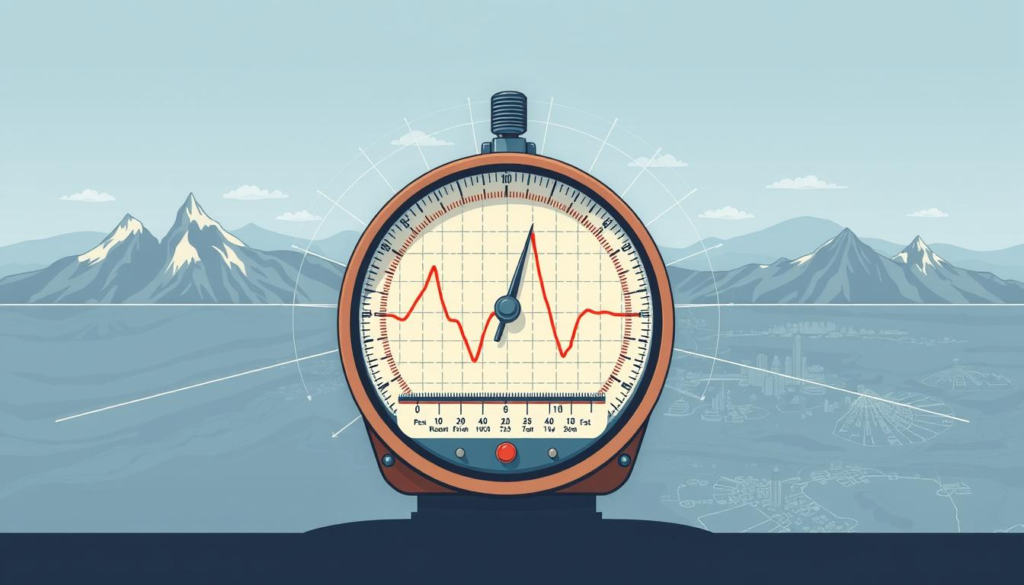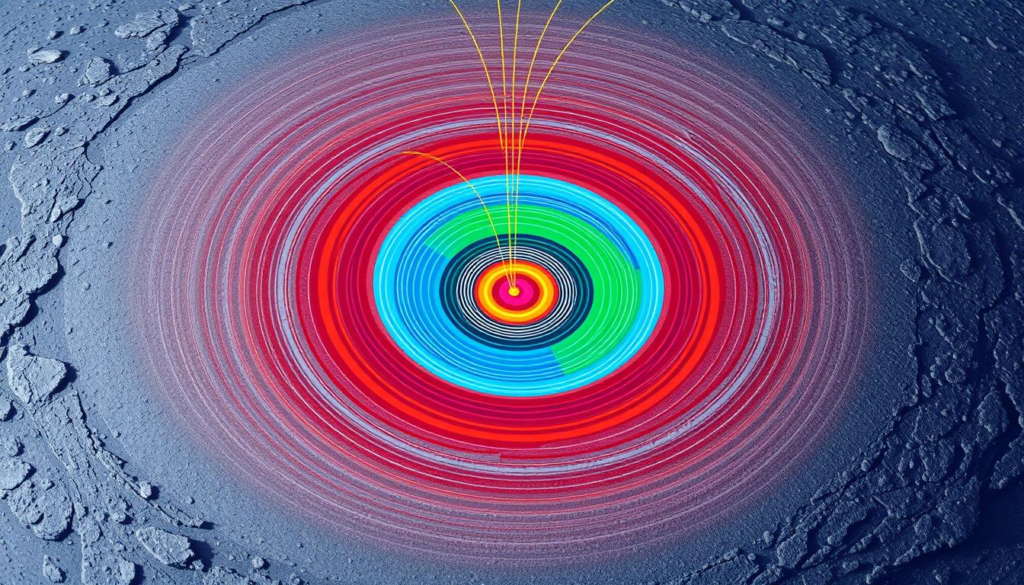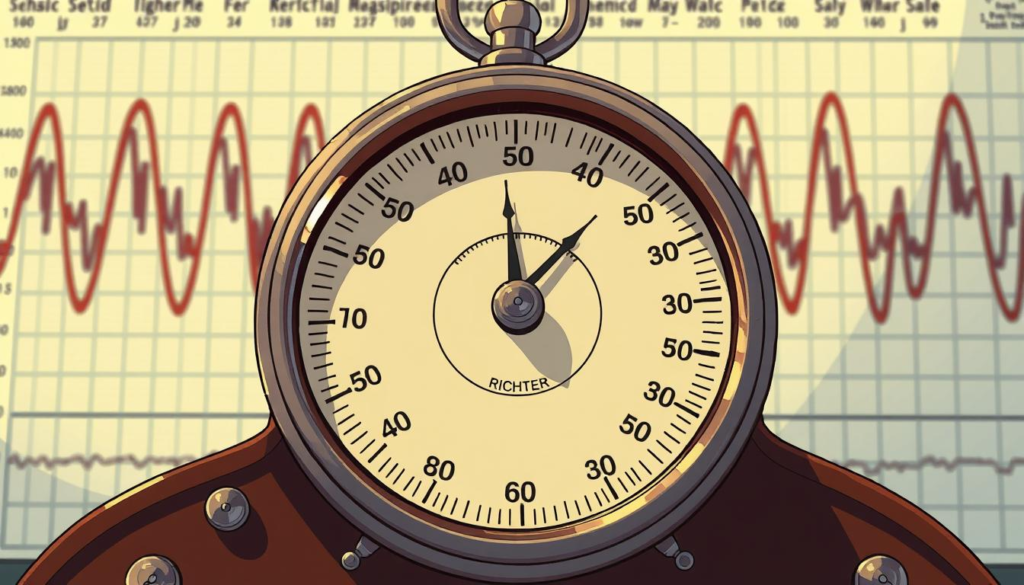How Earthquakes Are Measured: Ever curious about how earthquake strength is figured out? Learning about earthquake measurement is key to grasping their power.
We’ll look into different scales and methods scientists use, from the famous Richter scale to detailed seismographic analysis. Get ready to see earthquakes in a new light as we uncover how they’re measured and studied.

What is an Earthquake?
An earthquake is when the Earth’s surface shakes suddenly. This happens when energy in the Earth’s crust or upper mantle is released quickly. The energy moves as seismic waves through the Earth, making the ground shake. Earthquakes can be triggered by many things, like tectonic plate movements, volcanic activity, and human actions.
Understanding Seismic Waves
Seismic waves are vibrations that move through the Earth’s interior and on its surface during an earthquake. There are two main types:
- Body waves: These waves go through the Earth’s interior, including the core.
- Surface waves: These waves move along the Earth’s surface, causing a lot of ground motion and damage.
Causes of Earthquakes
Many things can cause earthquakes, including:
- Tectonic plate movements: When tectonic plates collide, move apart, or slide past each other, stress builds up. This stress can suddenly release energy, causing an earthquake.
- Volcanic activity: Volcanic eruptions and magma movement can also lead to earthquakes.
- Human-induced events: Activities like mining, filling reservoirs, and injecting fluids can sometimes cause small earthquakes.
Knowing how earthquakes happen is key to predicting, preventing, and responding to them.

The Richter Scale: A Classic Measure
The Richter scale is a well-known way to measure an earthquake‘s strength. It was created in 1935 by Charles Richter, an American seismologist. This scale helps us understand how much energy an earthquake releases.
The scale goes from 1 to 10. A higher number means a stronger quake. For example, a magnitude 7 earthquake is 10 times stronger than a magnitude 6. This scale is great because it shows the wide range of earthquake strengths worldwide.
| Richter Scale | Earthquake Magnitude | Description |
|---|---|---|
| 1.0 – 3.9 | Minor | Generally not felt by people, but detected by sensitive instruments. |
| 4.0 – 5.9 | Moderate | Can cause damage to poorly constructed buildings and other structures. |
| 6.0 – 6.9 | Strong | Can cause severe damage in a local area. |
| 7.0 – 7.9 | Major | Can cause widespread, serious damage. |
| 8.0 or higher | Great | Can cause catastrophic damage and loss of life. |
Even though the Richter scale is still useful, other scales like the Modified Mercalli Intensity Scale are also important. They give us more details about how earthquakes affect buildings and people.

Seismographs: Detecting Ground Motion
Seismographs are key in measuring earthquakes. They detect and record the ground motion from seismic waves. Scientists use this data to find out where and how big an earthquake was.
How Seismographs Work
Seismographs have a suspended mass that moves when the ground shakes. This movement is recorded and analyzed. It helps scientists understand the earthquake’s size and location.
These instruments are very sensitive. They can pick up even the smallest ground motion. By combining data from many stations, scientists get a full picture of the earthquake.
The data from seismographs helps us understand earthquakes better. As technology gets better, so does our understanding of ground motion and seismic activity.
Earthquake Magnitude: The Amount of Energy Released
When we talk about earthquakes, “magnitude” means how much energy they release. It’s not the same as intensity, which is how strong the shaking is in one place. The Richter scale measures this energy, giving us a clear picture of the earthquake’s power.
The Richter scale was created by Charles Richter in the 1930s. It goes from 0 to 9. Each number is ten times more energy than the last. So, a 6.0 earthquake has 31 times more energy than a 5.0.
The amount of energy released by an earthquake is measured by its magnitude, not how hard it shakes. This is key because the magnitude stays the same everywhere. But, how much shaking happens can change a lot, depending on where you are and the ground.
Knowing about earthquake magnitude helps us understand their huge power and danger. It also guides us in getting ready for earthquakes. Since earthquake is measured by its magnitude, it’s important for planning how to deal with them.
Earthquake is Measured by
Earthquakes are measured in different ways, like the Richter scale and seismographs. These tools help us understand how much energy an earthquake releases. The magnitude of an earthquake is a measure of the amount of energy released. The intensity shows how strong the shaking is in a certain place.
These measurements help scientists know how big an earthquake is. They also tell us how it might affect the area around it. This knowledge helps us get ready for and deal with earthquakes.
The earthquake is measured by looking at the seismic waves it creates. These waves tell us about the earthquake’s size and strength. Knowing this helps us understand the earthquake’s impact.
| Measurement | Description |
|---|---|
| Magnitude | A measure of the amount of energy released during an earthquake. Larger magnitudes indicate more energy and potentially more damaging effects. |
| Intensity | A measure of the strength of the shaking at a specific location. Intensity is influenced by factors like distance from the earthquake’s epicenter and local soil conditions. |
| Seismic Waves | The vibrations that travel through the Earth’s interior and surface, detected by seismographs. Analyzing these waves provides valuable information about the earthquake’s magnitude and location. |
By understanding how the magnitude of earthquake is measured by these factors, scientists can predict what might happen. They can then plan how to prepare for and respond to earthquakes.
Earthquake Intensity: Measuring the Shaking
Understanding the impact of an earthquake involves looking at intensity. The earthquake is measured by how much it shakes at a certain spot. The Modified Mercalli Intensity (MMI) scale is a key tool for measuring this.
The Modified Mercalli Intensity Scale
The MMI scale goes from I (barely felt) to XII (total destruction). It considers how people, buildings, and the environment are affected. This scale helps us see how an earthquake affects a community in detail.
The MMI scale has different levels:
- I (Barely Felt) – A few people at rest, especially on upper floors, might notice it.
- II (Weak) – A few people, especially on upper floors, might feel it.
- III (Slight) – People indoors, especially on upper floors, can feel it quite a bit.
- IV (Moderate) – Many people indoors feel it, with dishes and windows rattling.
- V (Rather Strong) – Everyone indoors feels it, with dishes and windows breaking.
- VI (Strong) – Everyone feels it, with heavy furniture moved and some chimneys damaged.
- VII (Very Strong) – It’s hard to stand, with buildings, including chimneys, monuments, and walls damaged.
- VIII (Destructive) – Buildings, including chimneys, monuments, and walls, suffer significant damage.
- IX (Ruinous) – Buildings, including chimneys, monuments, and walls, suffer great damage.
- X (Disastrous) – Wooden structures are destroyed, with most buildings damaged, and bridges and dams heavily damaged.
- XI (Very Disastrous) – Only a few structures remain standing, with bridges and dams destroyed, and railroad tracks bent.
- XII (Catastrophic) – Everything is destroyed, with lines of sight and level distorted, and objects thrown into the air.
Knowing about the modified mercalli intensity scale helps us understand how severe an earthquake is. It shows us the challenges communities face after an earthquake.
Hypocenter and Epicenter: Locating the Source
Understanding earthquakes means knowing about hypocenter and epicenter. The hypocenter is where the earthquake starts, deep inside the Earth. The epicenter is the spot on the ground above it. Finding these points helps us know how bad an earthquake might be and where to send help.
Finding the epicenter is the first step in studying an earthquake. Scientists use special methods to figure out where it is. This helps them guess where the shaking will be strongest.
The hypocenter tells us about the earthquake’s cause. By looking at its depth and location, scientists learn about the Earth’s movements. This knowledge helps them predict earthquakes and prepare for them.
Finding the hypocenter and epicenter is hard work. It needs a lot of seismic stations and smart data analysis. This info helps emergency teams, city planners, and leaders make safer places for everyone.
Seismology: The Study of Earthquakes
Seismology is the science that studies earthquakes and how seismic waves move through the Earth. Seismologists use tools like seismographs to learn about the Earth’s inside and why earthquakes happen.
Exploring Earth’s Interior
Seismologists study seismic waves to understand the Earth’s layers and what they’re made of. These waves come from the energy released during an earthquake. They let scientists see inside the Earth and find out about its core, mantle, and crust.

By looking at seismic waves, scientists learn about the Earth’s density, temperature, and makeup. This knowledge helps them understand plate tectonics, volcanoes, and other Earth changes. It also helps them figure out how to measure and deal with earthquakes.
Scientists keep studying seismology to uncover the Earth’s secrets. This helps them predict and lessen earthquake damage. It’s key for being ready for disasters and staying safe.
Preparedness and Safety Measures
Understanding how earthquakes are measured is key for better safety. Knowing the earthquake’s magnitude, intensity, and location helps emergency teams. They can then coordinate relief efforts and keep people safe.
Places prone to earthquakes can take steps to reduce risks. These steps include:
- Building codes that make sure buildings can handle earthquake shaking.
- Early warning systems that give people time to prepare for an earthquake.
- Disaster preparedness plans that guide actions before, during, and after an earthquake.
- Community education programs that teach people about earthquake safety.
By understanding how earthquakes are measured and taking safety steps, we can make communities stronger. This helps save lives when earthquakes happen.
In this article, you’ve learned a lot about how scientists measure earthquakes. They use the Richter scale and seismographs to understand magnitude, intensity, and where earthquakes happen.
Exploring the details of earthquake measurement helps us grasp the science behind them. Knowing about the amount of energy released and the hypocenter and epicenter is key. This knowledge is vital for staying safe and prepared.
The study of seismology helps us understand the Earth’s interior. It gives us insights into earthquakes. With this knowledge, we can improve how we predict and deal with these powerful events.
FAQ
What is an earthquake?
An earthquake is when the Earth’s surface shakes. This happens when energy suddenly releases in the Earth’s crust or upper mantle. This energy moves as seismic waves, causing the ground to shake.
How are earthquakes measured?
Earthquakes are measured in different ways. This includes the Richter scale, seismographs, and other tools that detect seismic waves. The magnitude shows how much energy was released. The intensity shows how strong the shaking was at a certain place.
What is the Richter scale?
The Richter scale is a way to measure earthquake strength. It was created in 1935 by Charles Richter. It ranges from 1 to 10, with higher numbers meaning stronger quakes.
How do seismographs work?
Seismographs detect and record ground motion from earthquakes. They measure seismic wave amplitude and frequency. This helps scientists figure out the quake’s magnitude and location. Seismographs use a suspended mass that moves with the ground, recording this movement.
What is the difference between earthquake magnitude and intensity?
Magnitude shows how much energy an earthquake releases. Intensity shows how strong the shaking was at a specific place. Magnitude is measured on the Richter scale. Intensity is measured on the MMI scale, which looks at effects on people, buildings, and the environment.
What are the hypocenter and epicenter of an earthquake?
The hypocenter is where the earthquake starts, inside the Earth. The epicenter is the point on the Earth’s surface above the hypocenter. Knowing these points helps understand the quake’s impact and guides emergency efforts.
What is seismology?
Seismology is the study of earthquakes and seismic waves. Seismologists use tools like seismographs to study the Earth’s interior. This helps them understand and predict earthquakes.
How can understanding earthquake measurement help with preparedness and safety measures?
Knowing how to measure earthquakes is key for safety. It helps emergency teams and local authorities plan better. It also guides efforts to make buildings safer and set up early warning systems in earthquake-prone areas.